Warning: Undefined array key "https://nctbsolution.com/ncert-exemplar-solutions-class-6-mathematics/" in /home/862143.cloudwaysapps.com/hpawmczmfj/public_html/wp-content/plugins/wpa-seo-auto-linker/wpa-seo-auto-linker.php on line 192
Ncert exemplar Solutions Class 6 Mathematics Geometry
Welcome to NCTB Solutions. Here with this post we are going to help 6th class students for the Solutions of NCERT Class 6 Mathematics Book, Unit 2, Geometry. Here students can easily find step by step solutions of all the problems for Geometry, Also here our mathematics teacher’s are solved all the problems with easily understandable methods with proper guidance so that all the students can understand easily. Here in this post students will get Unit 2 solutions.
Geometry Unit 2 Solution :
Multiple Choice Questions :
Question no – (1)
Number of lines passing through five points such that no three of them are collinear is
Solution :
The correct option is – (A) 10
Number of lines passing through five points such that no three of them are collinear is 10.
Question no – (2)
The number of diagonals in a septagon is
Solution :
The correct option is – (D) 14
The number of diagonals in a septagon is 14.
Question no – (3)
Number of line segments in Fig. 2.5 is
Solution :
The correct option is – (B) 10
Number of line segments in Fig. 2.5 is 10
Question no – (4)
Measures of the two angles between hour and minute hands of a clock at 9 O’ clock are
Solution :
The appropriate option is – (B) 270°, 90°
Measures of the two angles between hour and minute hands of a clock at 9 O’ clock are 270°, 90°.
Question no – (5)
If a bicycle wheel has 48 spokes, then the angle between a pair of two consecutive spokes is
Solution :
The correct option is – (B) (7 1/2)
If a bicycle wheel has 48 spokes, then the angle between a pair of two consecutive spokes is (7 1/2)
Question no – (6)
In Fig. 2.6, ∠XYZ cannot be written as
Solution :
The correct option is – (B) ∠ZXY
In Fig. 2.6, ∠XYZ cannot be written as ∠ZXY
Question no – (7)
In Fig 2.7, if point A is shifted to point B along the ray PX such that PB = 2PA, then the measure of ∠BPY is
Solution :
The correct option is – (B) 45°
The measure of ∠BPY is 45°
Question no – (8)
The number of angles in Fig. 2.8 is
Solution :
The appropriate answer is option – (D) 6
The number of angles in Fig. 2.8 is 6.
Question no – (9)
The number of obtuse angles in Fig. 2.9 is
Solution :
The correct option is – (C) 4
The number of obtuse angles in Fig. 2.9 is 4.
Question no – (10)
The number of triangles in Fig. 2.10 is
Solution :
The correct option is – (B) 12
The number of triangles in Fig. 2.10 is 12.
Question no – (11)
If the sum of two angles is greater than 180°, then which of the following is not possible for the two angles?
Solution :
Correct option is – (D) Two right angles.
Two right angles is not possible for the two angles.
Question no – (12)
If the sum of two angles is equal to an obtuse angle, then which of the following is not possible?
Solution :
Correct option is – (D) Two right angles.
Then two right angles is not possible.
Question no – (13)
A polygon has prime number of sides. Its number of sides is equal to the sum of the two least consecutive primes. The number of diagonals of the polygon is
Solution :
Correct option is – (B) 5
The number of diagonals of the polygon is 5.
Question no – (15)
In Fig. 2.12,
∠BAC = 90° and AD ⊥ BC.
The number of right triangles in the figure is
Solution :
The correct option is (C) 3.
The number of isosceles triangles in the figure is 3.
Question no – (16)
In Fig. 2.13, PQ ⊥ RQ, PQ = 5 cm and QR = 5 cm. Then ∆ PQR is
Solution :
Correct option is – (B) an isosceles right triangle
Then ∆ PQR is = an isosceles right triangle.
Fill in the blanks to make the statements True :
Question no – (17)
Solution :
An angle greater than 180° and less than a complete angle is called Reflex angle.
Question no – (18)
Solution :
The number of diagonals in a hexagon is 9.
Formula to find Diagonals of any polygon is [n x (n-3)] / 2
Where “n” is no. Of sides of polygon.
Hexagon having six sides. n = 6
Diagonals of Hexagon,
= [n x (n-3)] / 2
= [6 x (6-3)] / 2
= 6 x 3 / 2
= 18/2
= 9
Question no – (19)
Solution :
A pair of opposite sides of a trapezium are parallel.
Question no – (20)
Solution :
In Fig. 2.14, points lying in the interior of the triangle PQR are O, S that in the exterior are T, N and that on the triangle itself are P, Q, R, M.
Question no – (21)
Solution :
(a) AD = AB + BD
(b) AD = AC + CD
(c) Midpoint of AE is C
(d) Midpoint of CE is D.
(e) AE is Four times of AB.
AE = 4 × AB.
Question no – (22)
Solution :
(a) ∠AOD is a/an ___ angle
Measure of ∠AOD is 90°
∠AOD is a Right angle
(b) ∠COA is a/an ___ angle
Measure of ∠COA is 50°
∠COA is an acute angle.
(c) ∠AOE is a/an ___ angle
Measure of ∠AOE is 130°
∠AOE is an Obtuse angle.
Question no – (23)
Solution :
The number of triangles in Fig. 2.17 is 5.
Their names are ∆AOB, ∆AOC, ∆ACD, ∆COD, ∆ABC.
Question no – (24)
Solution :
Number of angles less than 180° in Fig. 2.17 is 15.
Their names are ∠OAB, ∠OBA, ∠AOB,∠OAC, ∠OCA, ∠AOC, ∠ODC, ∠OCD, ∠COD, ∠ACB, ∠ABC, ∠CAB, ∠ACD, ∠ADC, ∠DAC.
Question no – (25)
Solution :
The number of straight angles in Fig. 2.17 is FOUR.
Question no – (26)
Solution :
The number of right angles in a straight angle is Two and that in a complete angle is Four.
Question no – (27)
Solution :
The number of common points in the two angles marked in Fig. 2.18 is Two.
Question no – (28)
Solution :
The number of common points in the two angles marked in Fig. 2.19 is One.
Question no – (29)
Solution :
The number of common points in the two angles marked in Fig. 2.20 Three.
Question no – (30)
Solution :
The number of common points in the two angles marked in Fig. 2.21 is Four.
Question no – (31)
Solution :
The common part between the two angles BAC and DAB in Fig. 2.22 is Ray AB.
Two angles BAC and DAB in Fig. 2.22.
Both angles contains AB in their names.
Hence, AB is the common between two angles BAC and DAB
State whether the statements given are true (T)or false (F)
Question no – (32)
A horizontal line and a vertical line always intersect at right angles.
Solution :
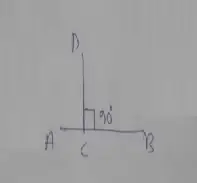
AB Horizontal line
CD vertical line
AB and CD interest at right angles
Thus, the statement is True.
Question no – (33)
If the arms of an angle on the paper are increased, the angle increases
Solution :
AB and CD are the arms the angle
If the arms of the angles increased the angle will not be increase
= ∠CDB = ∠XPY = 90°
Thus, the statement is False.
Question no – (34)
If the arms of an angle on the paper are decreased, the angle decreases
Solution :
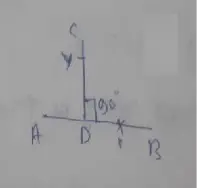
AB and CD are the arms of the angle If the arms are decreased and arms will be
AX and DY the angle will be the same
= ∠CDB = ∠YDX
Thus, the statement is False.
Question no – (35)
If line PQ || line m, then line segment PQ || m
Solution :
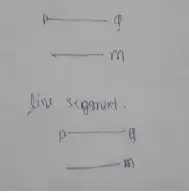
So, the above statement is True.
Question no – (36)
Two parallel lines meet each other at some point
Solution :
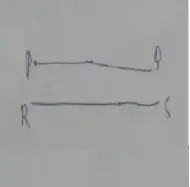
Two parallel lines never meet at any point.
So, the statement is False.
Question no – (37)
Measures of ∠ABC and ∠CBA in Fig. 2.23 are the same
Solution :
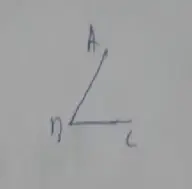
= ∠ABC = ∠CBA
Thus, the statement is True.
Question no – (38)
Two line segments may intersect at two points
Solution :
Two lines segment are in one line so they never can intersect.
Thus, the statement is False.
Question no – (39)
Many lines can pass through two given points
Solution :
Only one line can pass through two given points.
Hence, the statement is False.
Question no – (40)
Only one line can pass through a given point
Solution :
Many lines can pass through a given points.
Hence, the statement is False.
Question no – (41)
Two angles can have exactly five points in common
Solution :
Many lines can pass through a given points.
Hence, the statement is False.
Question no – (42)
Name all the line segments in Fig. 2.24
Solution :
There are 5 points on a line segments such as point A, B, C, D AND E.
Name of the line segments = Line segments AB, AC, AD, AE, BC, BD, BE, CD, CE, DE
Question no – (43)
Name the line segments shown in Fig. 2.25
Solution :
There are 5 points on a line segments such as point A, B, C, D AND E.
Name of the line segments = Line segments AB, BC, CD, DE, EA.
Question no – (44)
State the mid points of all the sides of Fig. 2.26.
Solution :
Mid points is the points lies in the middle of sides.
Midpoint of line AB is point Z.
Midpoint of line BC is point Y.
Midpoint of line CA is point X.
Question no – (45)
Name the vertices and the line segments in Fig. 2.27
Solution :
There are 5 vertices in the given fig.
Vertices are A, B, C, D and E
Line segment is the line joining the two points.
Line segments are AB, AC, AD, AE, BC, CD, and DE
Question no – (46)
Write down fifteen angles less than 180° involved in Fig. 2.28
Solution :
We have to find Angles less than 180° i.e. acute angles and obtuse angles.
Angles less than 180° are = ∠ADF, ∠DFC, ∠DCF, ∠CDF, ∠BEF, ∠BFE, ∠EBF, ∠FBC, ∠FCB, ∠BFC, ∠ABC, ∠ACB, ∠EAD, ∠AEF, ∠EFD
Question no – (47)
Name the following angles of Fig. 2.29, using three letters:
Solution :
(a) ∠1
Angle ∠1 Represent by three letters is ∠CBD
(b) ∠2
Angle ∠2 Represent by three letters is ∠DBE
(c) ∠3
Angle ∠3 Represent by three letters is ∠EBA
(d) ∠1 + ∠2
Angle ∠1 + ∠2 Represent by three letters is ∠CBE
(e) ∠2 + ∠3
Angle ∠2 + ∠3 Represent by three letters is ∠ DBA
(f) ∠1 + ∠2 + ∠3
Angle ∠1 + ∠2 + ∠3 Represent by three letters is ∠ CBA
(g) ∠CBA – ∠1
We know ∠CBA is ∠1 + ∠2 + ∠3
= ∠1 + ∠2 + ∠3 – ∠1 = ∠2 + ∠3
We know ∠2 + ∠3 is ∠DBA.
∠CBA – ∠1 = ∠DBA.
Question no – (48)
Name the points and then the line segments in each of the following figures (Fig. 2.30)
Solution :
Figure – (i)
There are 3 points A, B and C.
Line segments are AB, BC and AC.
Figure – (ii)
There are 4 points A, B, C and D.
Line segments are AB, BC, CD and DA.
Figure – (iii)
There are 5 points A, B, C, D and E.
Line segments are AB, BC, CD, DE and EA.
Figure – (iv)
There are 6 points A, B, C, D, E and F.
Line segments are AB, CD and EF.
Question no – (49)
Solution :
From above figures fig. 2 and 3 have midpoints which forms two equal parts of lines.
Point O is the midpoint of Line AB which forms two equal parts OA and OB.
Point D is the midpoint of Line BC which forms two equal parts BD and DC.
Question no – (50)
Solution :
(a) line segment to have two different lengths?
= It is not possible.
(b) angle to have two different measures?
= It is not possible.
Question no – (51)
Solution :
Sum of ∠ABC and of ∠CBD forms ∠ABD.
∠ABC + ∠CBD = ∠ABD
Yes. The measure of ∠ABC and of ∠CBD make measure of ∠ABD.
Question no – (52)
Solution :
Sum of line AB and line BC is equal to Line AC.
AB + BC = AC
YES. Lengths of line segment AB and line segment BC make the length of line segment AC
Question no – (53)
Solution :
Two acute angle and obtuse angle are –
Question no – (54)
Solution :
(a) A which is in the interior of both ∠1 and ∠2.
Point A which is in the interior of both ∠1 and ∠2.
(b) B which is in the interior of only ∠1.
Point B which is in the interior of only ∠1.
(c) Point C in the interior of ∠1.
Point C in the interior of ∠1.
Now, state whether points B and C lie in the interior of ∠2 also.
Yes. Points B and C lie in the interior of ∠2
Question no – (55)
Solution :
(a) Two rays with a common end-point
This statement is Correct.
(b) Two line segments with a common end-point
This statement is Incorrect.
(c) A ray and a line segment with a common end-point
This statement is Incorrect.
Question no – (56)
Solution :
(a) Perpendicular bisector is shown?
In fig. 2 Perpendicular bisector is shown.
Perpendicular bisector means which form right angle and divide line in two equal parts.
(b) Bisector is shown?
In fig. 2 and fig. 3 bisector is shown.
Bisector means which only divides lines in two equal parts.
(c) Only bisector is shown?
Bisector means which only divides lines in two equal parts.
In fig. 3 Only Bisector is shown.
(d) Only perpendicular is shown?
Perpendicular means which form right angle.
In fig. 1 only perpendicular is shown.
Question no – (57)
Solution :
Both the figures are made up of 3 line segments.
But, fig.2 is a closed figure, fig.1 is not closed figure.
Reason : Fig (2.36) is not triangle because it is not closed.
Question no – (58)
Solution :
No, if two rays interest,
Their Point of intersection will not the vertex of an angle of which the rays are the two sides.
Question no – (59)
Solution :
(a) Acute angles are the angles having measures less than 90°.
∠AEB, ∠ADE, ∠BAE, ∠BCE are the acute angles having measures less than 90°.
(b) Obtuse angles are the angles having measures greater than 90°
∠BCD, ∠BAD are Obtuse angles having measures greater than 90°
Question no – (60)
Solution :
(a) Is AC + CB = AB?
YES,
Because, AC + CB = AB
(b) is AB + AC = CB?
NO,
Because, AB – AC = CB
(c) is AB + BC = CA?
NO,
Because, AB – BC = CA
Question no – (61)
Solution :
(a) What is AE + EC?
From fig.
Sum of AE and EC is Line AC.
AE + EC = AC.
(b) What is AC – EC?
From fig.
We subtract EC from AC we get Line segment AE.
AC – EC = AE
(c) What is BD – BE?
From fig.
We subtract BE from BD we get Line segment DE.
BD – BE = DE.
(d) What is BD – DE?
From fig.
We subtract DE from BD we get Line segment BE.
BD – DE = BE
Question no – (62)
Solution :
In figure 2.40,
(a) ∠ABD
(b) ∠STR
(c) ∠ACD, ∠ACB
(d) ∠RTW, ∠STR
(e) ∠AED, ∠AEB, ∠BEC, ∠DEC
(f) ∠AREC
(g) ∠ACD
(h) ∠OKA, ∠AKP, ∠BKO
Question no – (63)
Solution :
(a) ∠ADB = ∠CDB
(b) ∠ABE = ∠CBE
(c) ∠ADC = ∠BDC
∠CAD = 90°, ∠CBD = 90°
Question no – (64)
Solution :
An angle is said to be trisected, if it is divided into three equal parts.
∠ BAC = ∠ CAD = ∠ DAE. Also BC = CD = DE
There are 2 Trisectors for ∠BAE which divides ∠BAE in three equal parts.
∠BAE = ∠ BAC = ∠ CAD = ∠ DAE. [∠BAE = ∠ BAC + ∠ CAD + ∠ DAE.]
Trisector AC and AD are 2 trisectors.
Question no – (65)
Solution :
In Fig.2.43 there are 2 point A and B are marked.
Question no – (66)
Solution :
Only one line segments are drawn from two points.
Question no – (67)
Solution :
In Fig 2.44, 3 points are marked and they are A, B, C
Question no – (68)
Solution :
There are 3 points A, B and C.
To find no. of line segments = No. of points x previous number / 2
No. of line segments
= 3 x 2 / 2
= 3
There are 3 line segments.
Line segments AB, BC, AC
Question no – (69)
Solution :
In Fig. 2.45, 4 points are marked and they are A, B, C, D
Question no – (70)
Solution :
To find no. of line segments = No. of points x previous number / 2
No. of line segments
= 4 x 3 / 2
= 6
There are 6 line segments.
Line segments are AB, AC, AD, BC, BD, and CD.
Question no – (71)
Solution :
In fig, 2.46, 5 points are marked,
They are A, B, D, E, C
Question no – (72)
Solution :
To find no. of line segments = No. of points x previous number / 2
No. of line segments
= 5 x 4 / 2
= 10
There are 10 line segments.
Line segments are AB, AD, AE, AC, BD, BE, BC, DE, DC, EC.
Question no – (73)
Solution :
(a) Name all chords of the circle.
= PC, AB
(b) Name all radii of the circle.
= OB, OP, OC, OA
(c) Name a chord, which is not the diameter of the circle.
= PC
(d) Shade sectors OAC and OPB.
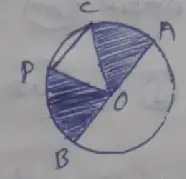
(e) Shade the smaller segment of the circle formed by CP.
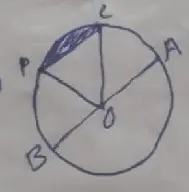
Question no – (74)
Solution :
(a) an acute angle? Why or why not?
Acute angles is the angles less than 900
When we add two acute angle
Eg. 240 + 340 = 580
When we add two acute angle, We get acute angles.
(b) a right angle? Why or why not?
Acute angles is the angles less than 900
When we add two acute angle
Eg. 450 + 450 = 900
The sum of two acute angles may be equal to a right angle.
(c) An obtuse angle? Why or why not?
Acute angles is the angles less than 900
750 + 500 = 1250
When we add two acute angle, we get obtuse angle.
The sum of two acute angles may be more than a right angle.
(d) a straight angle? Why or why not?
A straight angle is angle having measure 1800
When we add two acute angle,
890 + 890 = 1780
We get obtuse angle.
No, The sum of two acute angles is always less than 180°.
(e) a reflex angle? Why or why not?
Reflex angle is angle having measure greater than 1800
When we add two acute angle,
890 + 890 = 1780
We get obtuse angle.
No, The sum of two acute angles is always less than 180°.
Question no – (75)
Solution :
(a) Obtuse angle having measure greater than 900
Reflex angle is angle having measure greater than 1800
When we add two obtuse angle,
1050 + 1200 = 2250
We get Reflex angle.
Yes. The sum of two obtuse angles is always greater than 180° which is Reflex angle.
(b) Obtuse angle having measure greater than 900
Complete angle is angle having measure 3600
When we add two obtuse angle,
1790 + 1790 = 3580
We get Reflex angle.
No, The sum of two obtuse angles is always greater than 180°, but less than 360°
Question no – (76)
Solution :
(a) Vertices
In given fig.
Vertices of the prism A, B, C, D, E, and F are there.
(b) Edges
In given fig.
Edges of the prism are AB, AC, BC, BD, DF, FC, EF, ED, and AE.
(c) Faces of the prism shown in Fig. 2.48.
In given fig.
Faces of the prism are ABC, DEF, AEFC, AEDB, and BDFC.
Question no – (77)
Solution :
Sphere is a circular shaped 3-D figure.
Which has No edges, No faces and No vertices.
Question no – (78)
Solution :
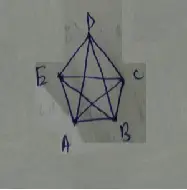
Diagonals are – AD, BD, AC, BE, CE
Next Chapter Solution :